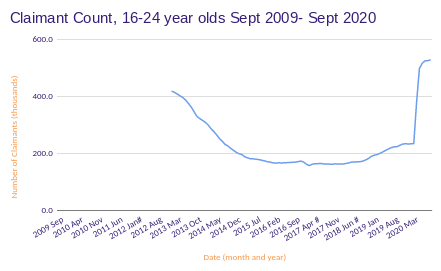The ONS have released the latest Labour Market Overview covering the months June – August, there is additional data that covers September.
The latest data set shows a swell in unemployment to 4.5%, we also see the largest rise in redundancies since 2009 and a further increase to the claimant count.
There are tentative signs of recovery in some industries as the total number of vacancies rose but there are still 40% less vacancies than this time last year.
Employment is down half a million since the pandemic began, young people are being disproportionately disadvantaged, 60% of those who have “fallen out of employment” are aged 16 – 24.
The Headlines
- The current number of people over 16 in employment is 32.59 million, 102,000 fewer than a year earlier and 153,000 fewer than the previous quarter.
- There are currently 1.52 million people unemployed, 209,000 more than a year earlier and 138,000 more than the previous quarter. The unemployment rate has continued to rise and is now at 4.5%, an increase of 0.4% on the quartet, and 0.6% on last year.
- There are an estimated 8.63 million people over the age of 16 economically inactive, 51,000 fewer than a year earlier and 3,000 fewer than the previous quarter. This translates to a rate of 20.8%
- The Claimant Count increased to 2.7 million. This represents a monthly increase of 27,000 and an increase of 1.5 million (120.3%), since March 2020.
- Redundancies increased to 227,000, up by 114,000 since the last quarter and 113,000 since the last year. The annual increase was the largest since April to June 2009, with the number of redundancies reaching its highest level since May to July 2009.
- There are now approximately 488,000 vacancies, which is a record quarterly increase of 144,000 vacancies from the record low in April to June 2020. However, this is still 40.5% less than this time last year.
What does this mean for youth employment?
Not all data has been released for 16-24 year olds -the Labour Force Survey has had to adapt the way data is collected during the pandemic. There has been a reduction in face-to-face interviews and as such are now done over the phone. This has resulted in an increased no-reply rate, whilst those who are replying tend to be homeowners. The Office for National Statistics has therefore included the housing situation of individuals in its methodology and will release data concerning the labour market participation (employment, education or training) of 16 to 24 year olds in November.
- The current number of 16-24 year olds in employment is 3.53 million.
- There are currently 581,000 16-24 year olds unemployed.
- There is an estimated 2.74 million people aged 16-24 who are economically inactive.
- The Claimant Count for 18-24 year olds stands at 529,000. This has increased 1,300 on last month, and an increase of 304,900 on last year.
 This graph displays the claimant count for 18-24 year olds since the last economic crisis in 2009. We can see more young people are claiming in this crisis. (Data Source: ONS)
This graph displays the claimant count for 18-24 year olds since the last economic crisis in 2009. We can see more young people are claiming in this crisis. (Data Source: ONS)
Our Concerns
The labour market figures today are unsurprising in that the effect of the pandemic is now being displayed through the statistics released. The employment rate is falling as the Coronavirus Job Retention Scheme (CJRS) comes to an end and other income support schemes come into play. We have seen a rise in economic inactivity as people were expecting to return to their jobs but as businesses start to make difficult decisions this has been translated into a rising unemployment rate and increased redundancies.
This month we expected to see a more complete picture of the impacts young people are facing during the pandemic, but also the results of lockdown measures on certain industries and whether various government support schemes had achieved their goal in stemming the impacts. However, due to ONS data collection and alterations to their methodology we will be able to access this data in November.
The Claimant Count is available and shows a steady increase in the number of 18-24 year olds who are on employment related benefits. Whilst this may include young people becoming unemployed, it will also contain those on a reduced income or reduced hours that are using Universal Credit to top up their income. This may not be a true reflection as the Youth Voice Census (2020) tells us that young people do not claim and that there is a stigma amongst their peers around JobCentre Plus and receiving benefits.
Although we see some positive signs in vacancies in Construction; Accommodation and Food; Wholesale & retail trade, repair of motor vehicles and motorcycles; the increases are relative to the current situation and are still significantly down on last year.
We must ensure young people are being prepared for the changing labour market, giving them the skills to succeed and drive the recovery of our economy. We must also be cautious of the potential effects of the new local lockdown measures and the potential place-based disadvantages that may result.
We are concerned as young people had told us that they were already uncertain about their futures, which has been exasperated during the pandemic, seen in a Prince’s Trust report. We know young people are more likely to work in shut-down sectors and new Covid-19 local restrictions may add to this uncertainty. There are then some concerns about place-based disadvantages and that those furthest away from the labour market may be pushed to the back of the queue.
We are working with government departments through advisory roles, the APPG for Youth Employment and the Youth Employment Group. We would like to see meaningful and quality education, employment and training opportunities for young people, ensuring that disadvantaged groups and those furthest away from the labour market.







